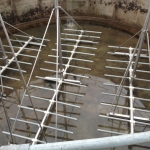For a Retrievable Aeration System – Should I use Disc Diffusers or Tube Diffuser?
By: Tom Frankel
Post Date: October 30th 2015
Once you have decided that your wastewater treatment plant needs a retrievable system, you will likely start looking at different types of grids and diffusers. Some of the things you need to consider are grid size, accessibility to the grids and tanks by crane, type of diffuser either fine bubble or coarse bubble, and type of diffuser.
Most retrievable grids made today are fine bubble grids, so in this post we will discuss fine bubble options. The most common ones are tube diffusers, disc diffusers, or plate diffusers. While there is a trend to build more retrievable grids with disc diffusers in some markets, most retrievable grids are built with tube diffusers. Tubes have the advantage in this specific case of being more neutrally buoyant, and building a retrievable grid usually involves stainless steel, so by selecting a plastic/rubber tube diffuser, you can reduce the amount of stainless steel in the grid, and also the amount of labor that goes into manufacturing and assembling the grid. However if you prefer disc diffusers, there are some tricks to reducing buoyancy and obtaining the highest possible oxygen transfer efficiencies.
Plate diffusers can also be used to make retrievable grids, but they tend to have a lot of buoyancy, so the ballast weight required with such grids can be significant. Likewise, larger diffusers can act like a “sail” and in case of hydraulic channel velocities, the grids can “dance”. To some extent guide rails and Y braces mounted to the floor can resist that movement, but we generally still prefer to recommend and build retrievable grids designed around disc or tube diffusers.
One more thing to consider is ragging. If you have a lot of rags in your process, due to inefficient screening, you may want a simpler retrievable grid design, without a lot of support bars. Generally those will be smaller grids.

Mr. Frankel co-founded SSI in 1995 with experience in design and distribution of engineered systems. He is in charge of sales, marketing and operations in the company. Mr. Frankel holds multiple US patents related to diffusers. He is a graduate of Washington University in St. Louis.


